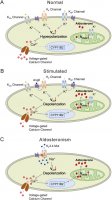md_a
Member
- Joined
- Aug 31, 2015
- Messages
- 468
The beneficial effect of Ang-(1-7) in alopecia can be attributed to their vasodilation action on blood vessels (Santos et al., 2000). The vasodilation of arterioles present in the dermis improves irrigation of the hair follicles, increasing the supply of nutrients and oxygen. Thus, the cells of the hair follicle increase their proliferation, accelerating hair growth
US20150313829A1 - Topical formulations for the prevention and treatment of alopecia and inhibition of hair growth - Google Patents
... Mineralocorticoid Receptor Blocker Increases Angiotensin-Converting Enzyme 2 Activity in Congestive Heart Failure Patients.
Abstract
Aldosterone plays an important role in the pathophysiology of congestive heart failure (CHF), and spironolactone improves cardiovascular function and survival rates in patients with CHF. We hypothesized that the mineralocorticoid receptor blockade (MRB) exerted its beneficial effects by reducing oxidative stress and changing the balance between the counter-acting enzymes angiotensin-converting enzyme (ACE) and ACE2. Monocyte-derived macrophages were obtained from 10 patients with CHF before and after 1 month of treatment with spironolactone (25 mg/d). Spironolactone therapy significantly (P<0.005) reduced oxidative stress, as expressed by reduced lipid peroxide content, superoxide ion release, and low-density lipoprotein oxidation by 28%, 53%, and 70%, respectively. Although spironolactone significantly (P<0.01) reduced macrophage ACE activity by 47% and mRNA expression by 53%, ACE2 activity and mRNA expression increased by 300% and 654%, respectively. In mice treated for 2 weeks with eplerenone (200 mg · kg−1 · d−1), cardiac ACE2 activity significantly (P<0.05) increased by 2-fold and was paralleled by increased ACE2 activity in macrophages. The mechanism of aldosterone antagonist action was studied in mouse peritoneal macrophages (MPMs) in vitro. Although ACE activity and mRNA were significantly increased by 250 nmol/L aldosterone, ACE2 was significantly reduced. Cotreatment with eplerenone (2 μmol/L) attenuated these effects. In MPM obtained from p47 knockout mice, where NADPH oxidase is inactive, as well as in control MPMs treated with NADPH oxidase inhibitor, aldosterone did not increase ACE or decrease ACE2. MRB reduced oxidative stress, decreased ACE activity, and increased ACE2 activity, suggesting a protective role for MRB by possibly increasing generation of angiotensin (1–7) and decreasing formation of angiotensin II. These effects are mediated, at least in part, by NADPH oxidase.
https://www.ahajournals.org/doi/10.1161/01.res.0000187500.24964.7a
US20150313829A1 - Topical formulations for the prevention and treatment of alopecia and inhibition of hair growth - Google Patents
... Mineralocorticoid Receptor Blocker Increases Angiotensin-Converting Enzyme 2 Activity in Congestive Heart Failure Patients.
Abstract
Aldosterone plays an important role in the pathophysiology of congestive heart failure (CHF), and spironolactone improves cardiovascular function and survival rates in patients with CHF. We hypothesized that the mineralocorticoid receptor blockade (MRB) exerted its beneficial effects by reducing oxidative stress and changing the balance between the counter-acting enzymes angiotensin-converting enzyme (ACE) and ACE2. Monocyte-derived macrophages were obtained from 10 patients with CHF before and after 1 month of treatment with spironolactone (25 mg/d). Spironolactone therapy significantly (P<0.005) reduced oxidative stress, as expressed by reduced lipid peroxide content, superoxide ion release, and low-density lipoprotein oxidation by 28%, 53%, and 70%, respectively. Although spironolactone significantly (P<0.01) reduced macrophage ACE activity by 47% and mRNA expression by 53%, ACE2 activity and mRNA expression increased by 300% and 654%, respectively. In mice treated for 2 weeks with eplerenone (200 mg · kg−1 · d−1), cardiac ACE2 activity significantly (P<0.05) increased by 2-fold and was paralleled by increased ACE2 activity in macrophages. The mechanism of aldosterone antagonist action was studied in mouse peritoneal macrophages (MPMs) in vitro. Although ACE activity and mRNA were significantly increased by 250 nmol/L aldosterone, ACE2 was significantly reduced. Cotreatment with eplerenone (2 μmol/L) attenuated these effects. In MPM obtained from p47 knockout mice, where NADPH oxidase is inactive, as well as in control MPMs treated with NADPH oxidase inhibitor, aldosterone did not increase ACE or decrease ACE2. MRB reduced oxidative stress, decreased ACE activity, and increased ACE2 activity, suggesting a protective role for MRB by possibly increasing generation of angiotensin (1–7) and decreasing formation of angiotensin II. These effects are mediated, at least in part, by NADPH oxidase.
https://www.ahajournals.org/doi/10.1161/01.res.0000187500.24964.7a

